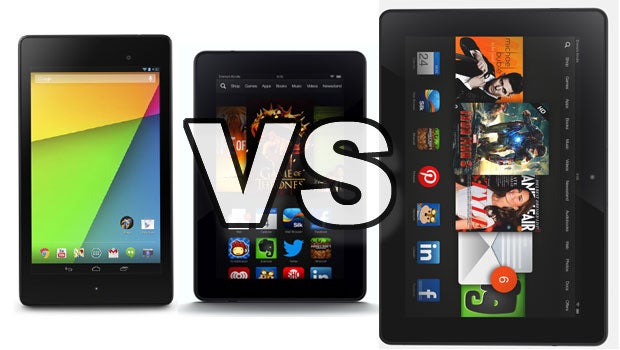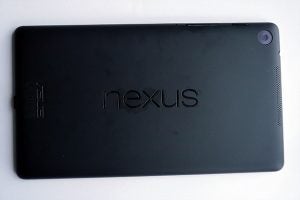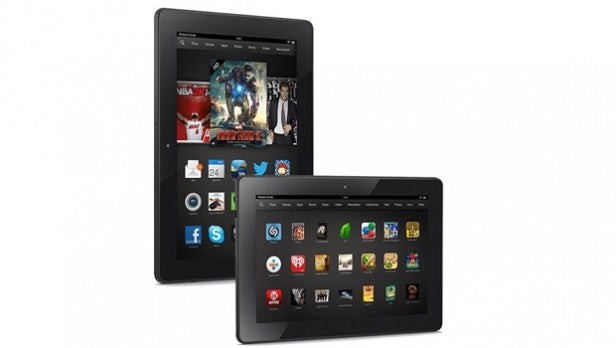Google Nexus 7 2 vs Kindle Fire HDX 7 vs HDX 8.9

The next wave of high-quality, low-cost Android tablets are here. The top contenders are the Google Nexus 7 2 and the two new Kindle Fire HDX tablets from Amazon.
There’s the 7-inch version and the larger Kindle Fire HDX 8.9. All three offer great specs at a low price. But which is the right one to go for?
Nexus 7 2 vs Kindle Fire HDX 7 vs HDX 8.9 – Design
Nexus 7 2 – Matt plastic back, 8.7mm thick, 290g
Kindle Fire HDX 7 – Matt and gloss angular plastic back, 9mm thick, 186mm wide, 303g
Kindle Fire HDX 8.9 – Matt and gloss angular plastic back, 7.8mm thick, 231mm wide. 374g
The Nexus 7 2 keeps its looks as simple as possible. It’s black, it’s covered in plastic and it bears little in the way of eye-catching bits beyond the Nexus logo on the back.
It’s no style icon, but it’s a very practical design that looks decent, will offend precisely no-one, and means the tablet doesn’t weigh much. It’s just 290g – which is feather-light for a tablet.
The Kindle Fire twins are altogether more striking. Their rears are again made of plastic, but use an angular design that’s out to give them a more recognisable look than most Android tablets.
It’s still a pretty inoffensive look, though.
The design issue we had with the first generation UK Kindle Fire tablets was that they were very heavy. Amazon has solved this with the HDX range. The smaller 7-inch tablet is just 303g – only 13g heavier than the Nexus 7 2, while the 8.9-inch edition is 374g. It’s significantly heavier, but this remains light for a tablet of its size, for example the iPad Air is 1.2-inches larger but weighs 469g. It’s slightly large for breezy one-handed use – but no more so than an iPad mini 2, really.
Last time around, the 8.9-inch Kindle Fire weighed 567g – some 10.1-inch tablet weigh less. The HDX are altogether much more practical tablets.
We’re giving this win to the Nexus 7, though, because it has a much narrower screen surround to the left and right (/top and bottom, depending on aspect), which is much more in keeping with current design trends. 
Excuse the fingerprints – here’s the Nexus 7 2
Nexus 7 2 vs Kindle Fire HDX 7 vs HDX 8.9 – Screen
Nexus 7 2 – 7-inch IPS screen, 1,920 x 1,200 pixel resolution, 323ppi
Kindle Fire HDX 7 – 7-inch IPS screen, 1,920 x 1,200 pixel resolution, 323ppi
Kindle Fire HDX 8.9 – 8.9-inch IPS screen, 2,560 x 1,600 pixel resolution, 339ppi
The screen quality competition between the Amazon and Google tablets is very difficult to judge. They all have top-quality screens, with similarly high resolutions that make images and text about as sharp as they can possibly be.
All three use the IPS screen type, which is great for angled viewing.
However, there have been some reports that the HDX tablets have imperfect colour reproduction, with a tint to the display that can come from less than perfect screen optimisation/quality assurance. We didn’t see anything like that in the Nexus 7 2.
For movie-watching, though, the 8.9-inch Kindle Fire HDX is easily the best of the three. Bigger is better when you’re watching a blockbuster, and the tablet also has better speakers than the other two.
Nexus 7 2 vs Kindle Fire HDX 7 vs HDX 8.9 – Power
Nexus 7 2 – Quad-core Snapdragon S4 Pro with 2GB RAM
Kindle Fire HDX 7 – Quad-core 2.2GHz Snapdragon 800 with 2GB RAM
Kindle Fire HDX 8.9 – Quad-core 2.2GHz Snapdragon 800 with 2GB RAM
The Amazon tablets are much more powerful than the Nexus 7 2. They all use Qualcomm processors, but the Kindle Fire HDX twins use the Snapdragon 800 chipset, which is newer and faster than the Snapdragon S4 Pro of the Nexus 7 2.
All three are quad-core CPUs, but the Nexus 7 is clocked at 1.5GHz, the Kindle Fires 2.2GHz – they also use more advanced processor cores, giving them an extra lead. Each tablet has 2GB of RAM.
Raw power is quite different from actual performance, but the Kindle Fire HDX tablets do have much more power on tap than the Google tablet.
Nexus 7 2 vs Kindle Fire HDX 7 vs HDX 8.9 – Software
Nexus 7 2 – Android 4.3
Kindle Fire HDX 7 – Custom Amazon UI Fire 3.0, Android Jelly Bean
Kindle Fire HDX 8.9 – Custom Amazon UI Fire 3.0, Android Jelly Bean
Real-world performance is dictated not just by specs, but by software too. The Nexus 7 2’s performance is superb, despite having a slightly behind-the-curve processor. It uses a vanilla version of the latest edition of Android, version 4.3, and as a result there’s little-to-no lag here.
The Kindle Fire HDX tablets use Android too, but with a thick custom interface dumped on top. Amazon calls it the Fire UI, and it looks nothing like Android.
It’s designed to get you consuming Amazon-owned content, from its music store, book store, the Amazon shop itself and LoveFilm (also owned by Amazon). You do not get access to Google Play, but Amazon’s own app store – yep it’s another way for Apple to make a few pennies off Kindle Fire owners.
In the past we’ve found the Fire UI to be slow and laggy, and to not have quite the apps selection we expect from an Android tablet. The Kindle Fire HDX and HDX 8.9 are not tablets for app fiends, but the Amazon App Store does offer a pretty reasonable selection these days. For the ‘full’ Android experience, though, the Nexus is the only choice here.
We’ll be back with more impressions on the Kindles’ performance once we’ve spent more time with them but – at best – they’ll be on-par with the Nexus 7 2.
Nexus 7 2 vs Kindle Fire HDX 7 vs HDX 8.9 – Storage
Nexus 7 2 – 16/32GB, non-expandable
Kindle Fire HDX 7 – 16/32/64GB, non-expandable
Kindle Fire HDX 8.9 – 16/32/64GB, non-expandable
None of these tablets offer expandable storage. You have what’s built into the thing, and that’s it.
The Nexus 7 2 comes in two capacities, 16GB and 32GB. Both Kindle Fire HDX tablets offer these, and a 64GB version.
But which offers the best value when ramping-up storage? You pay an extra £40 to go from 16GB to 32GB with a Nexus 7 2. It’s just £30 to do so with a Kindle Fire HDX 7 – but this is bumped up to £40 in the 8.9-inch version. There’s no real justification for this, but it’s hardly the most extortionate charge.
To go from 32GB to 64GB costs – once more – is an extra £30 with the HDX 7 and £40 with the HDX 8.9.
Nexus 7 2 vs Kindle Fire HDX 7 vs HDX 8.9 – Battery Life
Nexus 7 2 – 9 hours (3,950mAh)
Kindle Fire HDX 7 – 11 hours (4,550mAh)
Kindle Fire HDX 8.9 – 12 hours (mAh TBC)
Amazon tablets significantly outlast the Nexus 7 2 because – simply enough – they have larger batteries. The Nexus has a 3,950mAh battery, the Kindle Fire HDX 7 a 4,550mAh one. The exact size of the Kindle Fire HDX 8.9 battery hasn’t been released, but it must be comfortably the largest of the three as Amazon says you’ll get a full extra hour of charge compared to the smaller HDX 7. You get 11 hours out of an HDX 17, and 12 from a Kindle Fire HDX 8.9
Video tests, and Google’s own claims, show that the Nexus 7 2 lasts for a solid – if unremarkable – nine hours. Using a slightly smaller battery is likely one of the reasons why the Nexus is lighter than the 7-inch Kindle Fire HDX.
Amazon has clearly made battery stamina a focus, and that’s a good thing.
Nexus 7 2 vs Kindle Fire HDX 7 vs HDX 8.9 – Camera
Nexus 7 2 – 5-megapixel main camera, 1.2MP front
Kindle Fire HDX 7 – Front-facing 720p camera only
Kindle Fire HDX 8.9 – 8-megapixel main camera, 720p front camera
Tablet cameras are a tricky thing. They are ridiculed, but some people do use them. The Kindle Fire HDX 7 has just the one camera – a 720p video chat camera that sits above the screen.
Both the Kindle Fire HDX 8.9 and Nexus 7 2 have the full complement of cameras – one on the front, one on the back. The Kindle’s is higher-end – it has an 8-megapixel sensor where the Nexus 7 2’s is a 5-megapixel sensor. Neither camera has a flash, making them fairly useless in low-light conditions.
Verdict
All three of these tablets are well-made and offer lots of spec power for not much money. However, the custom interfaces used by the Kindle Fire HDX duo mean that tech enthusiasts should really go for the Nexus 7 2, even if the Amazon tablets are a bit more powerful. With great screens and light bodies, the battle is much more closely fought than it with the last generation of Nexus and Kindle Fire tablets, though.
Next, read our iPad mini 2 vs Nexus 7 2 comparison


